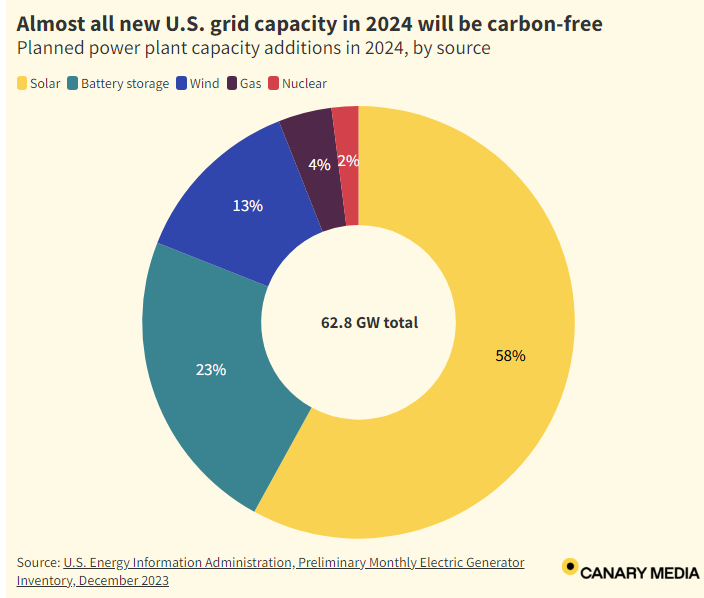Renewables, batteries and nuclear will add up to 96% of all new power capacity constructed this year, per federal data.
Canary Media’s chart of the week translates crucial data about the clean energy transition into a visual format.
Not long ago, people called wind, solar and batteries “alternative energy.” That old moniker has now lost its meaning: In 2024, the U.S. power industry is choosing clean energy for almost all its new capacity additions.
This is a big year for power plant construction generally. The U.S. is slated to build 55% more power capacity than it did in 2023; the Energy Information Administration says the 62.8 gigawatts expected to be added in 2024 will be the most built in a year since 2003.
But it’s poised to be a huge year for clean energy specifically.
The latest federal forecast for power plant additions shows solar sweeping with 58% of all new utility-scale generating capacity this year. In an upset, battery storage will provide the second-most new capacity, with 23%. Wind delivers a modest 13%, while the long-delayed final nuclear reactor at Vogtle in Georgia will add 2% of new capacity, assuming it does in fact arrive this year. That leaves fossil gas with just 4% of new power plant capacity, a decidedly meager showing for the fuel that still produces the most electricity annually.
The EIA’s numbers punctuate the stunning rise of renewables and batteries over the last decade. As mass manufacturing soared, costs fell precipitously, and developers gained hands-on experience in how to deliver these projects cost-effectively. Then, the 2022 Inflation Reduction Act created a host of tax incentives for companies to install clean energy over the coming decade.
Now, in 2024, everyone from investor-owned utility companies to cooperatives, municipals and private developers across 50 states has decided carbon-free energy would be the most competitive option to meet their power needs. The industry’s aggregate investment decisions mean that 96% of all new large power plant capacity will be carbon-free.
The U.S. set a record for large-scale solar construction last year, and 2024 is set to double that. Battery installations also set a record last year, with 6.4 gigawatts added. This year is set to double that, too, with 14.3 GW — and also nearly double the total installed grid battery capacity in the whole country. Almost all of those batteries will go to the booming solar markets of Texas and California, where they can soak up cheap surplus solar and play a meaningful role in averting power shortfalls during moments of extreme electricity demand.
By contrast, the 2.5 gigawatts of planned new gas plants represent the smallest addition for that fuel in 25 years.
But fossil gas still generates 40% of annual U.S. electricity, and coal produces about 20% (and falling). Each year like 2024 pushes renewable capacity far higher, squeezing out more expensive fossil fuel production. It’s hard to imagine a starker signal of the renewable era’s arrival than a near-total sweep of new power plant construction — now the clean energy industry just needs to keep it up.
– By Julian Spector, Maria Virginia Olano/Canary Media
23 February 2024







